
Published: May 6, 2024
In the current market, characterized by high volatility and rapid moves to the downside, reallocating capital towards assets demonstrating relative strength is key to continue being in the market.
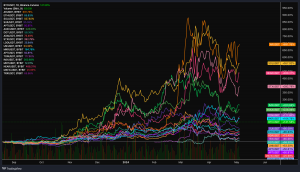
Source: velodata
$AR has notably outperformed during the most recent market corrections, showing unusual resilience as $BTC dominance increased and alts trended towards lower prices. These quick flushes provide great opportunities to reallocate capital from underperforming assets to higher quality options or “faster horses”.
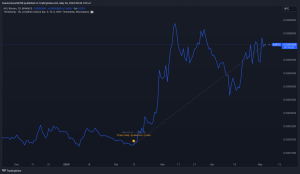
Source: tradingview – $AR/$BTC has been outperforming since the original tweet announcement for the release of AO the computer.
This tactical rotation capitalizes on the relative strength of assets like $AR during downturns, positioning the portfolio for potential incremental gains when the market rebounds. Conversely, maintaining positions in slower-moving, weaker assets during such times increases the risk of exacerbated losses if market conditions worsen. Overall, this presents a favorable environment for pairs trading, not blindly buying $AR, but also hedging and protecting ourselves from overall market risk.
Zooming out, Arweave is commonly recognized as a solution for decentralized data storage, often categorized with storage platforms like Filecoin, Storj, Siacoin, ShadowDrive, etc. Distinctly, Arweave has evolved beyond mere storage solutions, venturing into the AI narrative, with signs of replicating a rerating similar to $NEAR’s. The latest initiative, the AO Hyper Parallel Computer, attempts to solve the challenge of achieving infinite scalability and incubate an ecosystem of projects that can support multiple high-growth market sectors, such as AI, DePIN, autonomous agents, etc.
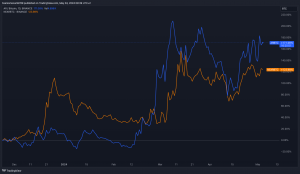
Source: tradingview – The $AR/$BTC chart has been outperforming the $NEAR/$BTC pair since March 2024.
While the release of AO in February is highly likely to be priced in, we might as well expect to see another large catalyst coming in the near term.
During the bear market, @fwdresearch focused on two major works. Last month we launched the first, @aoTheComputer.
Launch for the second is now on the horizon. Can’t wait to share it with you.
The new cyberspace will be built on Arweave. https://t.co/OjeATwSRep
— 🐘🔗 sam.arweave.dev (@samecwilliams) March 29, 2024
Source: Sam Williams on X – Hint at the release of another highly ambitious project.
Considering that Arweave can now be categorized as an AI project, it would be very opportunistic to release the announcement coinciding with NVIDIA’s earnings on May 22.
The team of Arweave is led by Sam Williams, who currently operates as the CEO. After graduating in 2014 with a First-Class Bachelor of Science with Honors (BSc Hons.) in Computer Science, Sam pursued a PhD at the University of Kent. During that time, Williams’ research focused on distributed systems and their scalability, which laid the foundational knowledge for Arweave’s unique approach to data storage.
The team around Williams has worked collectively to evolve Arweave since May 2017, taking the project from a simple conceptual framework into a functional, decentralized storage network. Notable members and contributors to the ecosystem include William Jones (co-founder and former CTO), and Tate Berenbaum (current CEO of Community Labs – a venture studio focused on building and accelerating the adoption and growth of the AO ecosystem).
A token sale of ~20% of the supply in June 2018 helped Arweave to secure ~$8.7M in funding. One year later in November 2019 Arweave raised $5M from a16z, USV, and Multicoin, to build out the “permaweb”. Those same investors doubled down again in March 2020, providing Arweave with $8.3M in funding alongside Coinbase Ventures.
Arweave operates as a decentralized storage solution, utilizing a blockchain-based protocol to offer permanent data storage. This is achieved with an economic model that involves charging a one-time fee for data storage, with the cost projected to cover data preservation indefinitely. This model leverages the concept of endowment, where upfront payments help fund long-term storage. Central to this vision of offering a global hard drive that ensures permanent storage is the $AR token, which not only allows the network to act as a data repository but will also help to power a vast ecosystem of applications built on top of AO.
📢 @ArweaveEco has been building something incredible:
A hyper parallel computer living inside Arweave.
PoS computation that lets any number of processes execute in parallel.
Oh, and it offers temporary storage.
All on Arweave.
Testnet: Live.
Join us: 2/27.@aoTheComputer. pic.twitter.com/9he989YvHx
— 🐘🔗 sam.arweave.dev (@samecwilliams) February 12, 2024
Source: Sam William’s tweet announcing the release of AO
The core technology behind Arweave is the “blockweave”, which represents an advancement over standard blockchains. It allows for random data verification, rather than sequential, which significantly lowers energy consumption and allows for the storage of petabytes of data at lower costs. This Proof of Access (PoA) consensus mechanism requires miners to prove they can access a random piece of historical data on the network. This incentivizes them to store as much data as possible, enhancing the data’s permanence and availability.
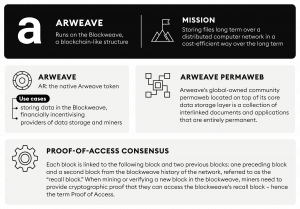
Source: Bitpanda Blog – Once uploaded, data can never be altered, thus increasing integrity and ensuring verifiability.
Arweave is a Layer 1 blockchain, acting as a foundational layer upon which additional technologies can be built. The permanent nature of data on Arweave also unlocks unique use cases that aren’t possible on mutable storage solutions. For instance, Arweave can support Proof of Ownership NFTs, archival systems for social media applications, a platform to address modern data concerns without the risk of unexpected deletions or alterations, etc.
Arweave’s core philosophy is that permanence equals provenance, providing an environment where files are preserved indefinitely and cannot be removed at whim. This immutability ensures that the entire history of a document or a webpage can be tracked without concerns of link rot or data disappearance. Users benefit from a reliable, tamper-proof record of information that conserves its integrity, and maintains its historical context and authenticity.
Arweave presents a solution to data preservation through an economic mechanism that leverages an endowment fund and takes into account declining storage costs. By leveraging the historically observed decline in storage costs—known as the Kryder rate—and incorporating operational factors into a modified Kryder+ rate, Arweave has built a system designed to outlast traditional storage models.
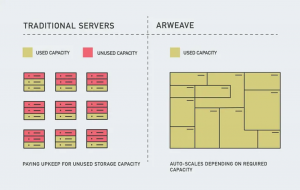
Source: Arweave Blog – Arweave’s Serverless Architecture
The economic model behind the protocol’s game theory calculates the upfront cost of storing data for 200 years. Based on the Kryder rate, Arweave takes a conservative estimate predicting a 0.5% annual decline in storage costs. This contrasts with the historical average of approximately 30%, severely underestimating future cost reductions and inadvertently extending the actual longevity of data storage well beyond 200 years, possibly up to 10,000 years.
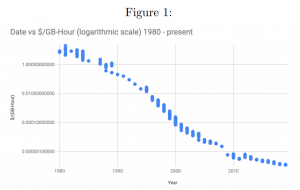
Source: arWiki – The cost of $GB/h has been on a steep decline
In order to use the network and store data, users pay a on-time fee, covering the estimated cost of 200 years of storage. Approximately 80% of this transaction fee is allocated to the endowment fund, which is designed to ensure the network’s sustainability by subsidizing miners if or when mining becomes unprofitable. However, this fund has never been needed since launch.
With over 80k $AR tokens (0.1% of the maximum supply), the endowment is a substantial financial resource that remains untapped, thanks to the current profitability of mining. This large reserve not only underwrites the network’s operational integrity but also underscores its financial health, creating deflationary pressure as many of those tokens might never be in circulation.
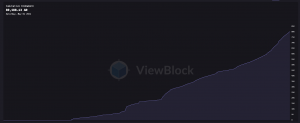
Source: viewblock.io – Cumulative Endowment
The locking away of a significant amount of $AR within the endowment fund effectively reduces its circulating supply, introducing a deflationary pressure on the token. This scarcity, coupled with the increasing demand for Arweave’s unique storage solutions with solutions like AO is exactly what could drive the token’s value higher over time.
For almost 6 years Arweave has been a permanent data layer. Now with AO, Arweave can also be a state layer for decentralized compute and code execution, being categorized alongside other parallel L1s. AO, which stands for Actor Oriented, is a computing system built on top of Arweave, designed as a hyper-parallel machine that makes it possible to compute and perform tasks simultaneously to enhance processing speeds and efficiency.
This scalability is crucial for handling large datasets and complex computations, particularly those required in fields like artificial intelligence (AI) and big data analytics. By leveraging the decentralized nature of Arweave, AO enables a distributed computing environment where all computations and their outcomes are permanently recorded on Arweave.
The ability to provide a trustless environment with verifiable computations and outcomes is critical for high integrity applications in fields such as scientific research, financial modeling, and legal document processing to name a few. AO utilizes a model that combines Erlang-style concurrency with Arweave’s decentralized storage, enabling scalable parallel computing. This setup allows AO to manage large datasets and complex computations typically required in AI applications efficiently.
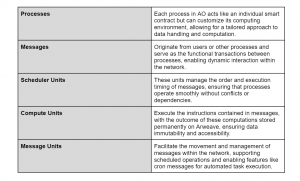
Key to AO’s capability is its use of a holographic state system, which instead of requiring consensus on the state of computation itself, keeps a log of interactions on Arweave. This method creates a consistent, determinable “hologram” of the state, allowing computations to be verified independently by any third party. The architecture ensures trustless computation and permissionless verification, which are pivotal for secure and transparent processing on a decentralized network.
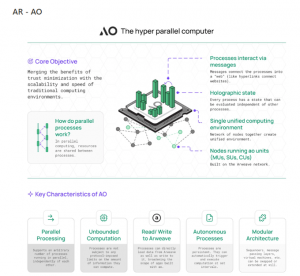
Source: Community Labs guide to AO
AO is designed as a Single System Image (SSI) environment, where processes, analogous to smart contracts, run independently yet interact seamlessly through message passing—without shared memory. This eliminates common bottlenecks like lock contention. Each process can customize its computing environment and accesses permanent on-chain data storage, further enhancing flexibility and scalability.
Moreover, AO supports a variety of development languages and frameworks, meaning developers from ecosystems like Ethereum, Solana, or others using EVM, SVM, WASM, or Lua can easily build on it.
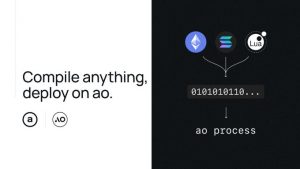
Source: Only Arweave on X – AO lets you plug in any virtual machine you like to build fully on-chain apps with the EVM, EVM, WASM, and more.
The $AR token is used as payment to put data on the blockweave network. When someone writes new data, they are charged a one-time fee in $AR, which gets divided into a) an upfront payment to pay for the initial storage costs for 200 years, and b) the reminder that goes into an endowment fund to pay for future storage costs (~80% of the fees paid).

Source: Arweave Fees
The assumption underpinning the economics of Arweave is based on a conservative annual decline in storage costs of only 0.5%. However, historical data shows that storage costs have declined by an average of 30.5% annually over the past five decades. If this trend continues or even if declines are less severe than historical averages, the endowment will more than suffice to cover the storage costs for periods extending well beyond the initial 200-year period. Meanwhile, the total supply of $AR is capped, which means that there is a finite number of tokens that will ever be available. This limited supply can help to drive the value of the token, especially as the demand for permanent data storage grows.
The endowment is not expected to be used any time soon. The projection is that it will remain untouched until Arweave’s permaweb grows substantially, even surpassing the current surface web. This expectation stems from the lower costs associated with storage. Since Arweave’s inception, no tokens have been withdrawn from the endowment. The continued decrease in storage costs means that fewer tokens will be needed from the endowment in the future, potentially leaving a significant portion unused.
Arweave’s model offers a compelling case for investment, particularly for those interested in the intersection of blockchain technology and long-term data storage solutions with AI use cases. The concept of the permaweb addresses a fundamental challenge in digital data storage, ensuring permanence. By storing data permanently on-chain, we can tackle the critical challenge of data provenance and authenticity, as well as make it available in a permissionless environment for others to build on top.
The most recent launch of AO, Arweave’s decentralized compute layer, has catalyzed a surge in platform activity, with transaction volumes witnessing a notable increase. This uptick is significant because every transaction processed on AO is permanently stored on the Arweave network. As AO continues to expand and attract more users and applications, the demand for Arweave’s storage capabilities is expected to grow correspondingly.
Beyond any plausible expectation of $AR tokens being rewarded with an $AO airdrop, what’s most relevant is that this trend highlights the symbiotic relationship between AO and Arweave’s core storage functionality. Meanwhile, $AR remains the only vehicle on the market to get exposure to AO.
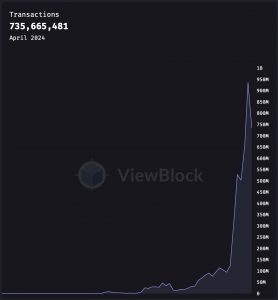
Source: viewblock.io – 700M+ transactions were recorded on Arweave this April
Compared to other parallel VMs, the fundamental difference between Arweave’s AO and platforms like Solana lies in their approaches to parallelism. Solana uses a shared memory model where all contracts can directly access and modify the memory of others synchronously. This design, while efficient up to a point, eventually encounters scalability barriers due to lock contention — where simultaneous access to data by multiple users creates a bottleneck.
In contrast, AO adopts a message-passing architecture where each contract, or ‘process,’ operates independently and communicates via messages. This model eliminates lock contention, allowing limitless scaling by simply adding more processes. Each process can function independently, similar to how separate programs run on a computer or nodes operate within the internet. This setup not only increases throughput but also enhances user experience by preventing the need for users to compete for system resources.
Even though there are tradeoffs to Arweave’s economic design, such a mechanism allows the network to differentiate itself from other chains and DePIN platforms that operate like traditional cloud services or storage solutions that charge recurring fees (and usually require large subsidies with token incentives). Arweave’s unique business model (pay once, store forever) positions the network as an ideal solution for markets that require immutable data storage, such as legal documents, historical records, and digital preservation, tapping into a need for secure, long-term data retention without ongoing costs.
The economic model underpinning Arweave, driven by the $AR token, further strengthens its market position. The $AR token, necessary for purchasing storage on the network, is prone to seeing increased value as demand for Arweave’s storage grows. This demand is bolstered by the platform’s ability to provide cost-effective, vendor lock-in free, and user-friendly decentralized storage options—qualities that are currently underrepresented in the decentralized storage market. Additionally, the launch of AO can take network activity to a whole different level, especially as more projects start to deploy autonomous agents or other use cases in the fields of DePIN and AI.
Because Arweave already had to solve the scalability of on-chain storage in order to build Arweave, they inherited this scalability ”’for free” by building AO with Arweave as its messaging layer. Evolving beyond storage, Arweave now supports AI computing through AO, facilitating parallel computation. This development, coupled with its scalable architecture, poises Arweave for broader applications, including agent-based finance (AgentFi – autonomous agents within smart contracts), decentralized AI training, etc.
Arweave is swiftly approaching the upper echelons of sustained transaction throughput (TPS) among public blockchains, recently peaking at over 1,000 TPS. This performance is nearing that of Solana, known for its high throughput, which averages ~500 TPS without vote transactions. The significant aspect of Arweave’s scalability lies in its unique architecture, which combines storage payments and service provision, theoretically removing traditional scalability limits.
Early utilization of the endowment for data storage contributes to a deflationary effect on the $AR token, as a substantial portion of tokens placed into the endowment may never be released. This adds an attractive layer to any given investment profile who is bullish on AI and Big Data, potentially leading to appreciation in $AR token value as demand for permanent storage solutions grows.
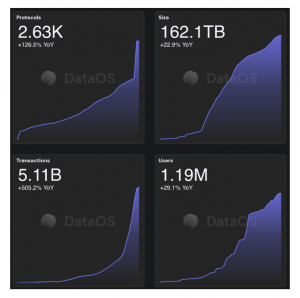
Source: dataOS Arweave stats – most meaningful metrics have been on an uptrend.
With 80k $AR in the endowment or 0.12% of the total supply, and 545k tokens left to mine, combined with an annual halving of rewards, Arweave’s economic model suggests a demand shift that applies deflationary pressure on token price by late 2025 or early 2026. This shift will occur as the rate of tokens entering the endowment outpaces those released through mining rewards.
Note that $AR is not deflationary in the sense of the tokens being burnt. Instead, we approach this problem from the perspective that when the rate at which tokens are locked in the endowment exceeds new tokens released, there is a deflationary effect as more tokens are effectively locked out of circulation.
As an extra catalyst, the Coinbase International Derivatives Exchange recently added support for Arweave, suggesting that a potential spot exchange listing might as well be on the horizon. Coinbase Ventures is also an early investor in $AR.
Additionally, we might as well expect the release of another highly ambitious project similar to AO, as hinted by Sam Williams on X.
AO opens up the space for building an ecosystem around Arweave that goes beyond the storage of historical artifacts. This ecosystem is supported by a range of entities, from non-profits to DAOs and venture studios, which offer grants and funding for projects.
The most obvious consequence is that many newcomers will want to engage with the expectation of potentially getting an airdrop, most likely to get exposure to $AO. In fact, the current number of unique wallet addresses is very low, with a cumulative count of ~200k.
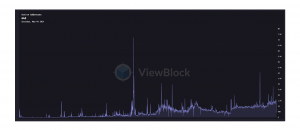
Source: viewblock.io – The number of active addresses is very low when compared to other L1s and L2s (443)
Currently AO Ventures is the main entity incubating ecosystem projects, with $35M in committed capital from leading investors FactionVC and Distributed Global. There is an ongoing 10-week incubator program where projects will be able to pitch to funds like a16z, 1kx or Coinbase Ventures among other VCs.
Other entities who are heavily aligned with the research and development of the ecosystem include Forward Research, Arweave SCP Ventures , Hansa Network, PermaDAO, Longview Labs, and Permanent VC. Also, the first AO Summit is happening on May 15, which can drive more eyeballs and catch public attention.
In less than 2 months AO went from being built in stealth to having a growing ecosystem. Notable projects include AOX (ao cross-chain bridge), the AstroUSD stablecoin, everPay (cross-chain payment infrastructure), ar.io (gateways and permanent domains), HarvestMkpl (tokenizing land, cattle, and gemstones on AO), The Data Os (protocol for AI-generated apps on top of Open Data Lakes), Autonomous Finance (AI-driven financial applications on AO), Alex (decentralized archival), etc.
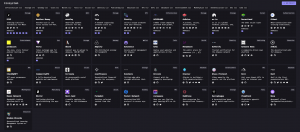
Source: viewblock.io – The Arweave ecosystem is set to continue expanding as more applications are deployed on top of AO.
The introduction of AO is already priced in, and the ecosystem growth is unlikely to move the needle as much as the actual release did, which triggered a 460% price increase at the local top from the February lows. If businesses and developers do not embrace Arweave for permanent data storage, demand for $AR may be limited as well.

Source: tradingview – $AR more than quadrupled in less than 30 days from the February lows to a local top in March 9 after AO was announced.
Ultimately, the value of $AR hinges on the utility and demand for permanent storage. If the economic model behind the token proves flawed or unsustainable, due to incorrect assumptions about storage costs, $AR could experience volatility or long-term depreciation. However, current supply and distribution trends suggest deflationary pressure. This contrasts with the ongoing meta of “VCs dumping on retail” with tokens that feature a low float and high FDV.
Nonetheless, in order to guarantee permanence, Arweave’s economic model presumes some conversion into fiat. When users pay in $AR and add funds to the endowment fund, they are theoretically “prepaying” for storage for N number of years. Note how this creates a currency mismatch, as $AR must hold or increase in value from when data is stored to have it stay “funded”. This becomes risky if Arweave fails to keep the token’s value stable or rising.
As we venture into bull market territory, new pricing cap limits make it more affordable for end users to continue adding data to the network. However, we can’t ignore that this is also exacerbating the previous assumption. In other words, Arweave implicitly promises the end user that they will “pay once and store forever”. Therefore, what’s actually happening is that the protocol is placing an X wager that the price of Arweave will stay above Y forever. In addition to that, the data in the network ends up being mixed in with everyone else’s data in the event that keeping the price above Y is not satisfied.
Additionally, current network incentives are designed for storage, and it’s unclear how $AR will benefit from AO’s success. One of the main concerns for miners might stem from the fact that the network might be running out of rewards to compensate for their activity, with only 545k tokens left to be mined.
Miners are currently receiving inflationary block rewards and transaction fees from data uploads. However, as these rewards run out, miners will still continue receiving transaction fees from data uploads. Additionally, even if we experience situations where transaction fees are lower than the cost of storage, the endowment will cover the difference during that time period.
Finally, it is also worth noting that despite the current reflexivity of better sentiment leading to price increases, it hasn’t always been like this. $AR is a token that barely moved during the bear market and the ongoing sentiment was that “nothing is going on”. This indicates that more efforts should be made on the business development and marketing side of things. Arweave was even included in the Forbes “Good for Nothing” list alongside chains like Cardano, Algorand, Tron, XRP, describing them as “Billion-dollar Zombies”.
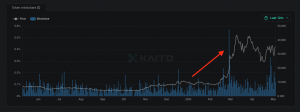
Source: kaito.ai – Token mindshare precedes large price movements to the upside
Given the unique value proposition, strong economic model, and potential for significant impact in the data storage, blockchain, and AI sectors, we believe that $AR warrants a strategic portfolio allocation.
Right now, the only way to frontrun the AO launch is by having exposure to $AR. Even though this is already priced in, the network is approaching a state of deflation where some tokens will never enter the circulating supply. Featuring one of the largest mcap/FDV ratios, this contrasts with the ongoing negative sentiment towards tokens with a low float and high FDV, which often result in VCs dumping on retail.
Arweave has outperformed for the large majority of the bull market, and that might not always be the case. However, it is definitely a good target to be used in the long leg of pairs trading strategies due to the relative strength it has been showing in both the ups and downs.
There is also the possibility that the market may still be pricing Arweave as a simple storage layer, while the release of AO represents something bigger and more ambitious, closer to a L1. This opens up the opportunity to treat $AR as an AI project itself, with AO acting as a parallel L1 computing layer that benefits from Arweave’s permanent storage. Moreover, a second project built on top of Arweave will be announced soon.
Revelo Intel has never had a commercial relationship with Arweave and this report was not paid for or commissioned in any way.
Members of the Revelo Intel team, including those directly involved in the analysis above, may have positions in the tokens discussed.
This content is provided for educational purposes only and does not constitute financial or investment advice. You should do your own research and only invest what you can afford to lose. Revelo Intel is a research platform and not an investment or financial advisor.